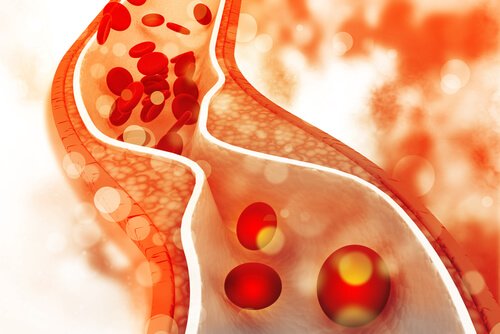High Cholesterol Levels in Children

You can fight high cholesterol levels in children with healthy lifestyle habits. A good diet and exercise make the best recipe to counteract this condition.
High cholesterol is also known as hypercholesterolemia or hyperlipidemia. It’s a disorder that may worsen from genetics, but it’s fundamentally due to poor diet.
The risk of cardiovascular disease is increasing. In Spain, for example, infant cholesterol affects an average of 2 out of 10 children. It has stopped being only an adult problem, and is moving to younger people.
Cholesterol is the fat (lipid) that the body needs to produce hormones and cell membranes. It is made in the liver and transported by blood.
There are three types of cholesterol:
- High-density lipoprotein (HDL). This is also known as the good cholesterol.
- The bad cholesterol is low density lipoprotein (LDL).
- Total cholesterol is the combination of both.
The process
HDL collects cholesterol from tissues and carries it to the liver. When your body receives more fat than it needs, there is an increase in LDL.
When there’s an excess of LDL, your body is at greater risk. Why is that? You’re more likely to suffer diseases, especially heart and stroke.
- Ideal levels should be below 110 mg/dl.
- HDL must be greater than 45 mg/dl.
- Total cholesterol should be less than 170 mg/dl.
- Triglycerides should be less than 90 for children ages 10 and older.

Risk factors
Diet, obesity and genetics are three factors that influence and increase hypercholesterolemia. Usually, the main cause is poor nutrition.
Fatty foods with low nutritional value contribute to the increase in infant cholesterol. Also, red meat and carbohydrates are determining factors. Consequently, consuming too many hamburgers, soft drinks and sweets are also harmful to children.
Eat sausages, organ meats, egg yolks, cold cuts, cured, soft and fresh cheeses at your own risk. This is because they have an excess of proteins.
On the contrary, fruits, vegetables, legumes, nuts and cereals such as rice lack bad cholesterol. In fact, you can eat them several times a day. Fish is one of the healthiest options.
Genetics
Most children with high cholesterol have one or both parents with the same condition. Even if you have other hereditary diseases, like diabetes or obesity, you need to test your blood.
Obesity
Being overweight is one of the causes of increasing childhood cholesterol. Similarly, having a sedentary lifestyle is a bad habit that also increases children’s risk.
Other diseases
If you have kidney or liver disease, hypertension, hypothyroidism, Kawasaki disease or diabetes, it’s even more important for you to take care of your life habits and seek medical advice. On the other hand, you also need to routinely get tested to check on your conditions.
Between ages 9 and 11 (and then between 17 and 21) many people forget about childhood cholesterol. If your child has risk factors, it should be the first thing you think of.
It affects the heart and brain the most
An excess of LDL in the blood builds up in the walls of the arteries that reach the heart and brain. The plaque that forms hardens and clogs blood vessels. It increases the risk of clots that can cause a heart attack or stroke.
When the arteries harden, which is called arteriosclerosis, blood flow to the intestines and kidneys decreases. Then, it’s important to pay attention to childhood cholesterol.

Importance of a healthy diet
A healthy diet, free of saturated fats, is essential to prevent and counteract poor cholesterol levels in children.
The monounsaturated and polyunsaturated fatty acids in fish, olive oil and seeds are an important part of this diet. Also, vegetable, legumes, cereals and fruits play a big role.
We recommend using low-fat dressings, sauces, and desserts. This is just as important as consuming skim milk, lean meats and fish. Avoid sugary and processed drinks, as well as red meats, in excess.
Exercises against high cholesterol levels in children
It’s essential to avoid a sedentary lifestyle at all costs. Walking, swimming, riding a bike or light running increase good cholesterol and reduce the bad one. It also lowers triglyceride levels.
One hour of activity per day is recommended for children over 5 years old. Video games or TV shouldn’t be the only extra “activity” children do everyday. They need to spend time in fresh air. They need to run, play and enjoy recreational activities.
Proper treatment
You can give your children medication for this condition once they’re 10 years old and have spoken with their doctor. If a healthy diet of 6 months doesn’t work, you need to take action.
When the bad cholesterol (LDL) is above 190 mg/dl, you need to consult your pediatrician. They need to evaluate your child to see if he or she needs to adjust the medication. The main thing is to be attentive and take care of your children’s health.
You can fight high cholesterol levels in children with healthy lifestyle habits. A good diet and exercise make the best recipe to counteract this condition.
High cholesterol is also known as hypercholesterolemia or hyperlipidemia. It’s a disorder that may worsen from genetics, but it’s fundamentally due to poor diet.
The risk of cardiovascular disease is increasing. In Spain, for example, infant cholesterol affects an average of 2 out of 10 children. It has stopped being only an adult problem, and is moving to younger people.
Cholesterol is the fat (lipid) that the body needs to produce hormones and cell membranes. It is made in the liver and transported by blood.
There are three types of cholesterol:
- High-density lipoprotein (HDL). This is also known as the good cholesterol.
- The bad cholesterol is low density lipoprotein (LDL).
- Total cholesterol is the combination of both.
The process
HDL collects cholesterol from tissues and carries it to the liver. When your body receives more fat than it needs, there is an increase in LDL.
When there’s an excess of LDL, your body is at greater risk. Why is that? You’re more likely to suffer diseases, especially heart and stroke.
- Ideal levels should be below 110 mg/dl.
- HDL must be greater than 45 mg/dl.
- Total cholesterol should be less than 170 mg/dl.
- Triglycerides should be less than 90 for children ages 10 and older.

Risk factors
Diet, obesity and genetics are three factors that influence and increase hypercholesterolemia. Usually, the main cause is poor nutrition.
Fatty foods with low nutritional value contribute to the increase in infant cholesterol. Also, red meat and carbohydrates are determining factors. Consequently, consuming too many hamburgers, soft drinks and sweets are also harmful to children.
Eat sausages, organ meats, egg yolks, cold cuts, cured, soft and fresh cheeses at your own risk. This is because they have an excess of proteins.
On the contrary, fruits, vegetables, legumes, nuts and cereals such as rice lack bad cholesterol. In fact, you can eat them several times a day. Fish is one of the healthiest options.
Genetics
Most children with high cholesterol have one or both parents with the same condition. Even if you have other hereditary diseases, like diabetes or obesity, you need to test your blood.
Obesity
Being overweight is one of the causes of increasing childhood cholesterol. Similarly, having a sedentary lifestyle is a bad habit that also increases children’s risk.
Other diseases
If you have kidney or liver disease, hypertension, hypothyroidism, Kawasaki disease or diabetes, it’s even more important for you to take care of your life habits and seek medical advice. On the other hand, you also need to routinely get tested to check on your conditions.
Between ages 9 and 11 (and then between 17 and 21) many people forget about childhood cholesterol. If your child has risk factors, it should be the first thing you think of.
It affects the heart and brain the most
An excess of LDL in the blood builds up in the walls of the arteries that reach the heart and brain. The plaque that forms hardens and clogs blood vessels. It increases the risk of clots that can cause a heart attack or stroke.
When the arteries harden, which is called arteriosclerosis, blood flow to the intestines and kidneys decreases. Then, it’s important to pay attention to childhood cholesterol.

Importance of a healthy diet
A healthy diet, free of saturated fats, is essential to prevent and counteract poor cholesterol levels in children.
The monounsaturated and polyunsaturated fatty acids in fish, olive oil and seeds are an important part of this diet. Also, vegetable, legumes, cereals and fruits play a big role.
We recommend using low-fat dressings, sauces, and desserts. This is just as important as consuming skim milk, lean meats and fish. Avoid sugary and processed drinks, as well as red meats, in excess.
Exercises against high cholesterol levels in children
It’s essential to avoid a sedentary lifestyle at all costs. Walking, swimming, riding a bike or light running increase good cholesterol and reduce the bad one. It also lowers triglyceride levels.
One hour of activity per day is recommended for children over 5 years old. Video games or TV shouldn’t be the only extra “activity” children do everyday. They need to spend time in fresh air. They need to run, play and enjoy recreational activities.
Proper treatment
You can give your children medication for this condition once they’re 10 years old and have spoken with their doctor. If a healthy diet of 6 months doesn’t work, you need to take action.
When the bad cholesterol (LDL) is above 190 mg/dl, you need to consult your pediatrician. They need to evaluate your child to see if he or she needs to adjust the medication. The main thing is to be attentive and take care of your children’s health.
All cited sources were thoroughly reviewed by our team to ensure their quality, reliability, currency, and validity. The bibliography of this article was considered reliable and of academic or scientific accuracy.
- Ahmad F., Leake DS., Lysosomal oxidation of LDL alters lysosomal pH, induce senescense, and increases secretion of pro inflammatory cytokines in human macrophages. J Lipid Res, 2019. 60 (1): 98-110.
- Ahmad F., Leake DS., Antioxidants inhibit low density lipoprotein oxidation less at lysosomal pH: a possible explanation as to why the clinical trials of antioxidants might have failed. Chem Phys Lipids, 2018. 213: 13-24.
This text is provided for informational purposes only and does not replace consultation with a professional. If in doubt, consult your specialist.








